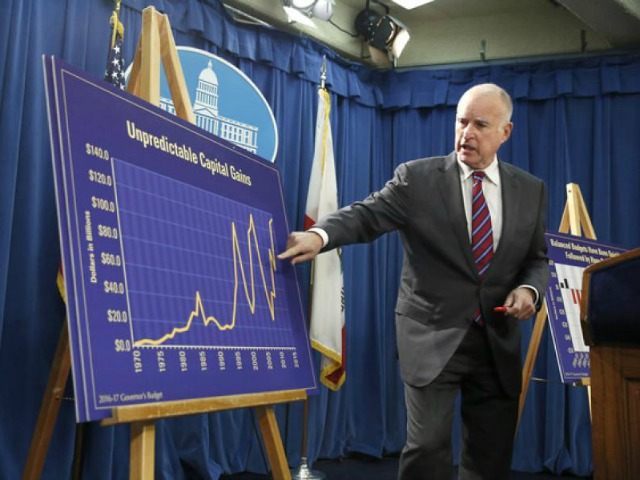California Gov. Jerry Brown has submitted his May revised 2018-2019 budget, which indicates he will leave office in January with the maximum $13.5 billion rainy-day fund.
Brown, a liberal Democrat, has complained that no politician should face the type of catastrophic financial crisis he inherited when he returned at age 72 on January 3, 2011 for his third term as the state’s chief executive officer.
At the time, outgoing Republican Gov. Arnold Schwarzenegger’s finance department was forecasting a $28.5 billion deficit over the next 18 months and California had been already been downgraded by to the lowest credit rating of any state in the nation.
Most political observers thought Brown might be the worst possible California governor for the crisis, given that after being termed out of office after eight years in 1983, he left newly elected Republican Gov. George Deukmejian with what was considered at the time a hellacious budget deficit of $1.5 billion.
But Brown badgered his Democrat majority allies in California’s legislature to slash the budget deficit by $14 billion through spending cuts and fund transfers. Despite howls from progressives, Brown whacked $1.1 billion from the University of California and California State College systems and sliced $1.7 billion from Medi-Cal spending.
Seven years later, Brown’s budget revision indicates that California tax receipts for 2017-2018 fiscal year ending in June are up by $8 billion compared to his finance team’s January budget estimate. That was after paying for “substantially higher program costs and ongoing commitments it has made and expanded in recent years, such as Medi-Cal, Cal Grants, child care, In-Home Supportive Services and foster care reform.”
Brown is proposing to spend another $2 billion on infrastructure, $359 million more on the homeless, and $312 million more to mental health support services.
The revised budget also trumpets the governor’s success in pushing up K-14 educational funding from a recession-debilitated $47.3 billion in his first 2011-2012 budget to a 67 percent higher $78.4 billion for 2018-2019 budget year.
One of the keys to Brown’s last five supposedly surplus budgets has been jacking up the state’s top income tax to a national high of 13.3 percent and spiking the sales tax rate.
The Tax Foundation’s effective tax burden for what the average American actually spends on local and state taxes was 9.9 percent in 2017. California has moved up under Brown to the fourth-highest in the nation, with a combined tax burden of 11 percent.
But the biggest reason Brown has generated surpluses has been California taxpayers realizing highly volatile capital gains that jumped from about $50 billion when he took office in 2011, to over $120 billion per year since 2014.
Brown’s May revised budget sees more economic expansion in the future. But the budget proposal does warn that “a moderate recession will drop state revenues by over $20 billion annually for several years.”
In that environment, Brown’s $13.5 billion rainy day fund would disappear in about 8 months.

COMMENTS
Please let us know if you're having issues with commenting.